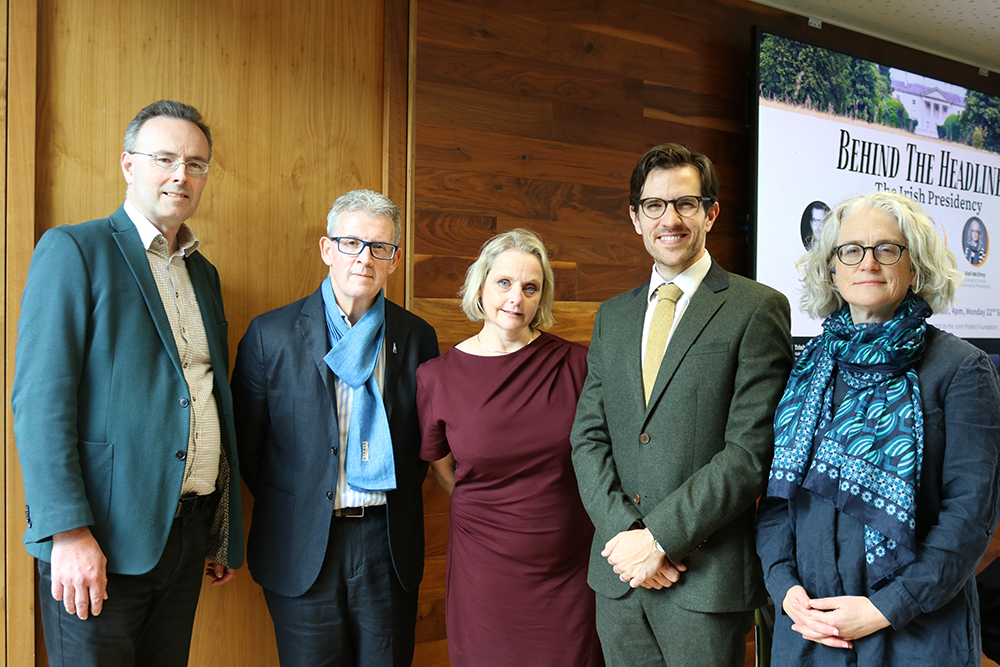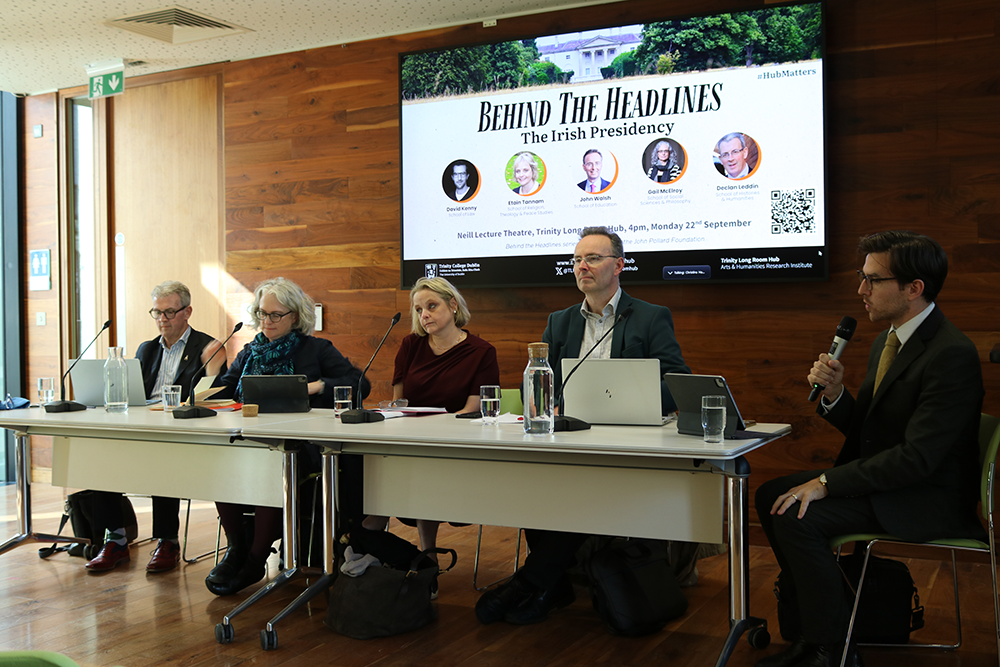In the Trinity Long Room Hub’s latest Behind the Headlines discussion panellists looked at the role of the Irish President and its “evolution” over time. Touching on some memorable moments throughout the 20th century and up to present day, the speakers also reflected on the change that was ushered in around the nature and role of the presidency with the 1990 election, and presidencies thereafter.
Chairing the event as part of the Trinity Arts and Humanities Research Festival, Professor David Kenny of Trinity’s School of Law was joined by Etain Tannam (Religion, Theology, and Peace Studies); John Walsh (Education); Gail MacElroy (Political Science); and Declan Leddin (former Ministerial adviser).
Early days
Introducing the discussion and alluding to the “evolution” of the presidential office over time, Professor David Kenny noted early debates on the Irish Constitution, where “some people said the President was going to be an autocrat and a bit like a dictator.”
“There weren’t many directly elected head of states when it was written into the Irish Constitution in 1937”, argued Gail McElroy, Professor in Political Science at Trinity College, Dublin. Perhaps not entirely unique in its formation, she said it was unusual in its powers, although she added that the constitutional powers of the presidency have been “very, very rarely used.”

Professor McElroy is currently writing the chapter on the 2025 Irish Presidential election in the new edition of The Irish Presidency: Power, Ceremony and Politics (editors – John Coakley and Kevin Rafter). Going back to the inception of the Irish Constitution, she asked “did Ireland really need a head of state in 1938?”
President Patrick Hillery
Dr John Walsh from Trinity’s School of Education is the author of Patrick Hillery: the official biography. Speaking on the panel, Dr Walsh, said there was “no presidential election between 1974 and 1990”, and because President Patrick Hillery wasn’t directly elected, he had “no popular mandate.” Dr Walsh argued that presidencies since 1990 have been able to mobilise a “certain level of soft power” and take a more authoritative stance on issues of public concern.
Despite a “low-profile” presidency, Dr Walsh described how during the papal visit of Pope John Paul II in 1979, President Hillery was the subject of a fake rumour alleging an affair with “at least one, possibly two women”. This rumour spread through the press corps in Dublin forcing the President to hold a press conference outlining what the rumour was and why he wasn’t resigning, said Dr Walsh. Many will also remember the later episode between President Hillery and Charlie Haughey, where the President refused to answer phone calls from Mr. Haughey to Áras an Uachtaráin, for fear of sparking a constitutional crisis.
1990 election
Declan Leddin, a former Ministerial adviser and postgraduate of Trinity’s School of Histories and Humanities, described working on Mary Robinson’s “transformational” campaign when he was in his early 20s. Having gone on to work on every presidential election since then, Mr Leddin said that the Irish citizen’s view of the presidency all changed after Mary Robinson’s election.

He argued that her campaign around liberalising laws around contraception, divorce and decriminalising homosexuality had important impacts on the trajectory of those issues within five years of her presidency. Mr Leddin also spoke about his political memory of the campaign, addressing also Fianna Fáil Minister Padraig Flynn’s controversial ‘family’ remarks about Mary Robinson, and the resulting anger of the electorate.
Proactive presidents
Dr Etain Tannam also alluded to the “shift” that occurred with the 1990 election. She said that ushered in an era of more “proactive presidencies”, nearly all of whom focused on bridge-building and reconciliation across the island. Etain Tannam, Deputy Director of the Trinity Long Room Hub and Associate Professor of International Peace Studies, is the author of British-Irish Relations in the Twenty-First Century (OUP, 2024).
She said President Michael D. Higgins, who presided over the decade of centenaries and was also hosted at Buckingham Palace, has taken a much more “hands on and assertive” approach, particularly in his second Presidency.
From Royal visits to a new inclusive approach to the Unionist communities in Northern Ireland, Dr Tannam said Robinson, McAleese, and Higgins were “proactive and political in a way that hadn’t happened before” but that “none of it broke the constitutional rules.”
The Trinity Long Room Hub Behind the Headlines series is supported by The John Pollard Foundation.
The next Behind the Headlines will take place on the 3 November 2025 and reflect on the upcoming 40th anniversary of the Anglo-Irish Agreement. Details will be announced soon at www.tcd.ie/trinitylongroomhub
